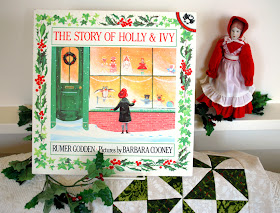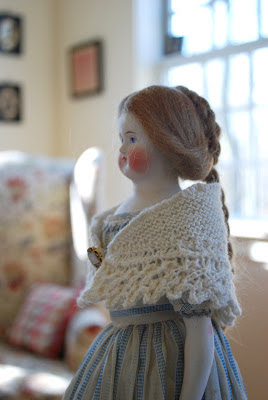A Dickens of a Christmas
At a gathering my mother met the great-grandson of Charles Dickens. Cedric
Dickens is his name. He was selling his book, Christmas with Dickens. My mother bought a copy for me and Cedric Dickens
autographed it. Isn’t this neat? That was ten years ago or so.
The book is a framework of ideas on how to create A Christmas Carol evening. Cedric Dickens and his cousin edited the Carol
to 28 minutes of reading aloud. The host or
hostess acts as the master of ceremonies. Recipes are provided in the book for
a banquet.
Filling the house with greenery is suggested. Period clothing and period music are optional. Between the courses selections of the Carol are read (with feeling, it is emphasized). Later come parlor games and punch. Although never as elaborate, I have adapted some of the ideas within our family and over the years we have extended the hand of hospitality to friends and neighbors.
Filling the house with greenery is suggested. Period clothing and period music are optional. Between the courses selections of the Carol are read (with feeling, it is emphasized). Later come parlor games and punch. Although never as elaborate, I have adapted some of the ideas within our family and over the years we have extended the hand of hospitality to friends and neighbors.
Traditions were formed by degrees. Several Christmases stand out. Looking
at our little tree this year, I recall the simplest Christmas of all. It was in
1986.
In 1986 we spent Christmas in London, England. Joining the volunteer
efforts of a Christian literature mission Dean and I had come for the year with
two suitcases each – and our two daughters - then age 2 and 4. We were prepared
to live simply. But how appreciative we were when we were able to move from a
tiny third-floor flat into a semi-detached house. We thoroughly enjoyed its
back garden.
Along the edges of the narrow, fenced-in lawn, were plants that took
turns blooming through the months. The largest was an overgrown holly. I
trimmed a branch, brought it indoors, propped it up on a table, and decorated
it with popcorn and paper chains. I cut a star out of cardboard, covered it
with (you guessed it) silver foil. The star balanced on the top of our crooked
little “tree.” Secretly, I thought it drab. But in the eyes of my children it
was fine and dandy – and so – for their sake - I thought it fine and dandy,
too.
A month prior a fellow American had handed me a bag of puzzles, plastic
toys and picture books that her children had long outgrown. She was, “just now
getting around to cleaning out their closets and would your girls like them?” I
thanked her and hid the things away to be wrapped for Christmas.
I remember my girls sitting cross-legged in the middle of the carpet
listening to a cassette. They played it again and again. Sometimes I sat with
them. Other times I took advantage of the moment to start supper. At the sound
of the beep the eldest knew to turn the pages of the accompanying book. With
heads together they gazed at the pictures of Joseph and Mary and the lowly
stable. They were quite taken up with the Christmas story – even if the
incarnation – one of the most marvelous and important doctrines of the
Christian faith – was something they would grow to understand better, later –
and yet it is too wonderful to comprehend this side of heaven, really. I can
still hum the melody of the sweet song that came at the beginning and end of
story. I wonder what ever happened to that cassette – narrated beautifully in
the King’s English.
One Saturday in December Dad took us to the missionary closet. We could
choose what we wished from what had been donated. After an hour of rummaging,
trying on things in a curtained corner - elbowroom only and no mirror - we
each settled upon a piece of clothing. I’ll never forget the beautiful wool
skirt that fit me perfectly – except that I was in denial of it being rather
snug at the waist. It was moth eaten in an inconspicuous spot and easily
mended. This soft, black skirt, with its ruffle along the hem, had a nice
drape. Add a white blouse with a red ornament on its collar, and it looked
smart for Christmas Eve service. Wool provided necessary warmth for sitting in
the chilly pews of the ancient stone church – Christ Church Bromely.
With our new used things and a
couple tiny treats for the girl’s stockings, (literary their socks) Christmas Day
arrived with smiles all around. After dinner (a meal that Dad relished) we put
on our coats and took a walk around the block. The brick houses sat close to
the sidewalk and I couldn’t help notice, through the windows of the front
parlors, people sitting in chairs arranged in a circle. I found it odd that
they were wearing brightly colored paper hats. I learned later that they were
waiting for parlor games to start.
Parlor games on Christmas Day became a tradition much later in our
lives. With all the years we spent reading A Christmas Carol, listening to it on audio, and watching it on films,
it eventually caught on. Perhaps you play them, too.
"There was first a game of blindman’s buff." A Christmas Carol
It was our Yolanda who initiated Charades, which I explained in a post
last year, “Name That Hymn” is one that I started and it stuck. It is a way to
give closer attention to lyrics – some of the most precious in all of
Christendom. It is fun to include lines from contemporary songs, too.
After the main course is cleared the game is played. One by one, each
person seated around the table, unfolds his slip of paper and reads it aloud.
He then guesses the hymn title. Although my family is pretty good at answers,
lines from a third verse can be a challenge. The guesser is permitted to choose
one person to assist. A sudden remark blurted out from across the table of “Ohh, I know,” identifies a willing
assistant.
But Mom urges, “Give him a minute first, please.”
"There is nothing in the world so irresistibly contagious as
laughter and good humor." A Christmas Carol.
I typed out some examples. A hostess will enjoy choosing her own lines.
1) A thrill of hope the weary world rejoices, For yonder
breaks a new and glorious morn.
2) Bless all the dear children in Thy tender care, And fit
us for heaven, to live with Thee there.
3) Word of the Father, now in flesh appearing.
4) Where meek souls will receive Him still, The dear Christ
enters in.
5) On the sixth day of Christmas my true love gave to me
(what is it?).
6) Where the treetops glisten and children listen to hear
sleigh bells in the snow.
The hostess keeps the corresponding answers handy.
1) O Holy Night
2) Away in the Manger
3) O Come all Ye Faithful
4) O Little Town of Bethlehem
5) six geese a laying
6) White Christmas
 |
| I've been meaning to decorate with pineapple on the fireplace mantel for some years. The apples are editble, too. |
My children aren’t little any longer. “Time has stolen them from me” – as one Victorian poem sentimentally refers. While children are with us we work to give them a foundation of pleasant memories – especially because the details of this world are not all fine and dandy.
Mom and Dad share the memories. The children grew up and grew into
making a memorable Christmas for others. They’ve learned that the advent season
is less about material gifts. It is the giving of oneself in various ways and
celebrating the joy and true meaning of Christmas.
“. . . apples and oranges were put upon the table, and a
shovel-full of chestnuts on the fire. Then all the Crachit family drew round
the hearth . . . “ A Christmas Carol
In Fellowship assembled here
We thank thee Lord for food and cheer
And through our Saviour, thy dear Son,
We pray “God bless us everyone.”
Prayer [for the table] discovered by Alan S. Watts,
President of the Dickens Fellowship, during research for his book, Dickens
at Gad’s Hill.
Peace and Good Will,
Karen Andreola




















































